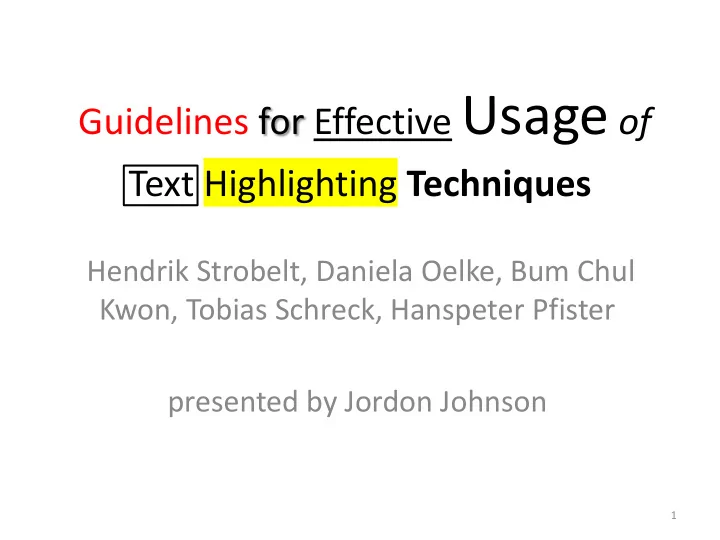

Guidelines for Effective Usage of Text Highlighting Techniques Hendrik Strobelt, Daniela Oelke, Bum Chul Kwon, Tobias Schreck, Hanspeter Pfister presented by Jordon Johnson 1
Many text vis tools… http://textvis.lnu.se/ 2
… but sometimes need to read text with annotations (WHY) bold font and yellow background e x t r a s p a c i n g and italics 3
Design study...-ish • Elicits requirements from domain experts – separate interviews with 5 NLP experts • Carries out user studies to evaluate techniques • All evaluated techniques have been in use for decades – similar to a study of the relative effectiveness of different marks and channels 4
Requirements (WHAT) Annotations can be: • statistical • categorical – word length • ordered • syntactic • quantitative – parts-of-speech • boolean • semantic – sentiment tags • structural • of any textual scope – page margins • overlapping • domain-specific – proper names 5
Pop-out is key Characters/words are marks that are fairly densely packed and regularly spaced, and that already make use of some visual channels To make highlighting detectable, need to maximize pop-out 6
Common highlighting techniques (HOW) • Each technique can also encode boolean features (scope of paper limited to this consideration) • 9 techniques used in user studies 7
3 User Studies • Performed using Amazon Mechanical Turk • Analysis techniques: ANOVA and Tukey HSD • Unwanted variation – Individual difference: normalized each participant’s responses with respect to their performance range – Learning curve: discarded first trials in first study, added training trials in others – Fatigue effects: not observed 8
Study 1: Ranking Techniques • Goal: rank techniques with respect to pop-out • 673 words, 20 randomly highlighted – Find as many highlighted words as possible within a time limit • 45 participants • 3 trials per technique (27 trials total) per participant – trials ordered randomly 9
Study 1 - results 10
Study 1 - discussion Possible explanations of strong results: • Increased font size: sticks out from cap line, fill white space • Border: makes the target appear larger • Colour: strong pop-out effect – background may outperform text colour because coloured area is larger 11
Study 1 - discussion Possible explanations of weak results: • Letter spacing: already a n o r m a l feature of text • Italics: slanted character features already found in text 12
Study 2: Search with Distractor • Goal: determine how different techniques (A,B) interfere when used in the same text – Is relative strength of techniques a factor? • 20 highlighted words for each of A, B, A+B – must choose words highlighted only with A • 30 participants • All pairs of techniques tried (72 trials total) per participant 13
Study 2 - results weaker techniques did not expect improvements 14
Study 2 - results 15
Study 2 - results 16
Study 3: Visual Conjunctive Search • Goal: How strong is a combination of techniques (A,B) compared to each alone? • 20 highlighted words for each of A, B, A+B – must choose only A+B • 24 participants • All pairs of techniques tried (36 trials total) per participant 17
Study 3 - results results similar to study 2 Only underlined + spacing showed improvement over both individually 18
Study 3 - results 19
Guidelines Scenarios: • Only one feature should be highlighted • Both features should have the same visibility; conjunctive visual search is not important • Conjunction of features is more important than each individually • One feature is significantly more important than the other • Both features should have the same visibility; their conjunction should be easy to see 20
Only one feature Choose a technique with strong pop-out Examples: • Font size • Borders • Yellow background 21
Same visibility; conjunction unimportant Choose techniques with strong pop-out that do not significantly interfere with each other Examples: • Bold + yellow background • Border + red • Font size + yellow background • Font size + border 22
Conjunction of features more important than each individually Choose techniques that scored high in visual conjunction test Examples: • Border + red • Font size + red • Font size + yellow background 23
One feature significantly more important than the other Choose techniques such that one has significantly higher pop-out Examples: • Yellow background + spacing • Font size + underlined • Border + italics 24
Same visibility, easy-to-see conjunction Choose techniques with strong pop-out that do not significantly interfere with each other, whose conjunction is easy to see Examples: • Border + red • Font size + yellow background • Yellow background + bold 25
Discussion/Future Work Increase scope • Combinations of more than two techniques • Include more techniques (eg. different colour combinations • Include categorical/ordered/quantitative data • Include tasks that require context/analysis • Consider overlay visualizations 26
Comments/Critiques • The guidelines for some scenarios are very similar, and multiple examples cover multiple scenarios – 3 studies for 5 scenarios – Some scenario refactoring would not be amiss • I would have liked to see a larger scope – The authors don’t misrepresent the scope – A larger scope would be a lot more work – BUT a larger set of matrices might reveal more clusters to fit the scenarios better 27
Comments/Critiques • I would have liked to see a statement of expected results, based on existing understanding of marks and channels 28
Are there any q u e s t i o n s ? 29
Recommend
More recommend